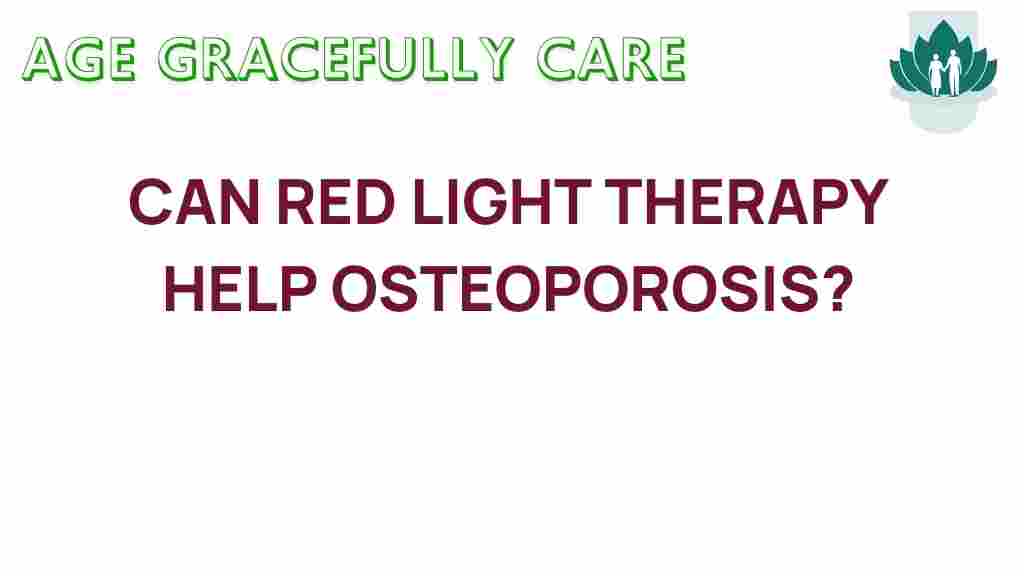Unveiling the Potential: Can Red Light Therapy Combat Osteoporosis?
Osteoporosis is a condition characterized by weakened bones, increasing the risk of fractures and breaks. As the population ages, the prevalence of osteoporosis is rising, making it a significant public health concern. Traditional treatments often involve medications, dietary changes, and lifestyle adjustments. However, alternative medicine approaches, such as red light therapy, are gaining attention for their potential benefits in enhancing bone health. In this article, we will explore how red light therapy may serve as a promising treatment for osteoporosis.
Understanding Osteoporosis
Osteoporosis is often referred to as a silent disease because it progresses without noticeable symptoms until a fracture occurs. This condition affects millions of people worldwide, particularly postmenopausal women and older adults. It is characterized by:
- Loss of bone density
- Weakened bone structure
- Increased fragility and risk of fractures
The primary factors contributing to osteoporosis include hormonal changes, nutritional deficiencies, lack of physical activity, and certain medical conditions. Understanding these factors is crucial in the management and prevention of this condition.
What is Red Light Therapy?
Red light therapy, also known as low-level laser therapy (LLLT), utilizes specific wavelengths of light to promote healing and improve cellular function. This non-invasive therapy has been used in various medical fields, including dermatology, pain management, and now, potentially, in treating osteoporosis.
The therapy works by penetrating the skin and stimulating cellular processes in the body. It is thought to enhance mitochondrial function, leading to increased ATP production, which is vital for cellular energy and repair. This mechanism may play a significant role in improving bone health.
How Red Light Therapy May Benefit Bone Health
Research into red light therapy and its effects on bone health is still emerging, but several studies suggest that it could offer potential benefits for those suffering from osteoporosis:
- Bone Density Improvement: Some studies indicate that red light therapy can stimulate osteoblasts, the cells responsible for bone formation, which may help improve bone density.
- Fracture Healing: Red light therapy has been shown to accelerate the healing process of fractures, promoting faster recovery and reducing pain.
- Inflammation Reduction: Chronic inflammation can exacerbate osteoporosis. Red light therapy may help reduce inflammation, contributing to better bone health.
- Enhanced Blood Circulation: Improved circulation can facilitate nutrient delivery to the bones, further supporting bone health.
Research Supporting Red Light Therapy in Osteoporosis Treatment
Several research studies have explored the effects of red light therapy on bone health:
- A study published in the Journal of Photochemistry and Photobiology found that red light stimulation significantly increased bone mineral density in animal models.
- Another research article highlighted that low-level laser therapy enhanced the healing of bone fractures in rats, indicating its potential for clinical applications in humans.
- Clinical trials are ongoing to assess the effectiveness of red light therapy in improving bone density and reducing fracture risk in human patients with osteoporosis.
Step-by-Step Process for Using Red Light Therapy
If you are considering incorporating red light therapy into your osteoporosis treatment plan, here is a step-by-step guide:
- Consult Your Healthcare Provider: Before starting any new treatment, consult with your doctor or a healthcare professional to ensure it is appropriate for your condition.
- Choose the Right Device: Select a high-quality red light therapy device designed for home use or seek professional treatment at a wellness clinic.
- Follow Treatment Protocols: Adhere to the recommended treatment protocols, which may vary based on the device. Most treatments last between 10 to 20 minutes, several times a week.
- Monitor Your Progress: Keep track of your symptoms and any changes in your bone health. Regular follow-ups with your healthcare provider can help assess the therapy’s effectiveness.
Troubleshooting Tips
While red light therapy is generally considered safe, some individuals may encounter challenges. Here are some troubleshooting tips:
- Skin Sensitivity: If you experience skin irritation, reduce the duration of exposure or increase the distance from the light source.
- Device Malfunction: Ensure your device is functioning correctly and follow the manufacturer’s instructions for use.
- Lack of Results: If you do not notice improvements in your bone health, discuss with your healthcare provider about adjusting your treatment plan or exploring additional therapies.
The Role of Lifestyle in Bone Health
While red light therapy may offer promising benefits for combating osteoporosis, it should be part of a comprehensive approach to bone health. Here are additional lifestyle changes to consider:
- Nutrition: Consume a balanced diet rich in calcium and vitamin D, essential for bone health. Foods such as dairy products, leafy greens, and fortified foods can help.
- Exercise: Engage in weight-bearing and resistance exercises to strengthen bones and improve balance.
- Avoid Smoking and Limit Alcohol: Both smoking and excessive alcohol consumption can weaken bones and increase fracture risk.
- Regular Check-ups: Monitor your bone health with regular check-ups and screenings as recommended by your healthcare provider.
Conclusion
Osteoporosis is a serious condition that requires proactive management. While traditional treatments play a vital role, exploring alternative medicine options like red light therapy may provide additional benefits for bone health. With ongoing research supporting its use, red light therapy shows promise as a complementary treatment in combating osteoporosis.
As always, it is crucial to consult with healthcare professionals before starting any new therapy to ensure safety and effectiveness. By combining red light therapy with a healthy lifestyle and traditional treatments, individuals can take proactive steps toward maintaining their bone health and overall wellness.
For more information on osteoporosis and treatment options, visit National Osteoporosis Foundation and learn how to manage your bone health effectively.
Incorporating these strategies can empower you on your journey towards better bone health and wellness.
This article is in the category Health and created by AgeGracefullyCare Team
